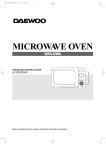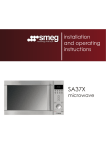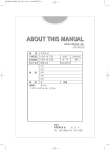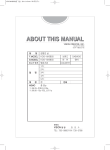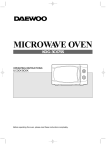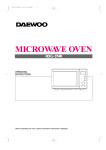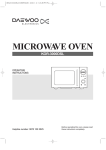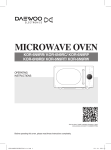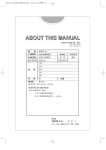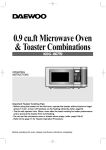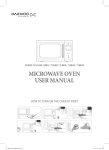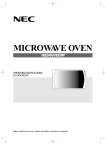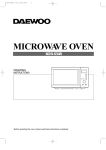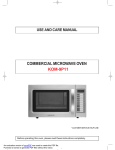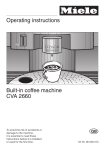Download Daewoo KOG3000SL microwave
Transcript
MICROWAVE OVEN
KOG-3000SL
OPERATING INSTRUCTIONS
& COOK BOOK
Before operating this oven,
please read these instructions completely.
}Helpline number: 0870 100 2525
PRECAUTIONS TO AVOID POSSIBLE EXPOSURE
TO EXCESSIVE MICROWAVE ENERGY
(a) Do not attempt to operate this oven with the door open since open-door operation can result in
harmful exposure to microwave energy. It is important not to defeat or tamper with the safety
interlocks.
(b) Do not place any object between the oven front face and the door or allow soil or cleaner residue
to accumulate on sealing surfaces.
(c) WARNING : If the door or door seals are damaged, the oven must not be operated until it has been
repaired by a competent person : (1) door (bent), (2) hinges and latches(broken or loosened), (3)
door seals and sealing surfaces.
(d) WARNING : It is hazardous for anyone other than a competent person to carry out any service or
repair operation which involves the removal of a cover which gives protection against exposure to
microwave energy.
(e) WARNING : Liquids or other foods must not be heated in sealed containers since they are liable to
explode.
(f) The appliance is not intended for use by young children or infirm person without supervision. Young
children should be supervised to ensure that they do not play with the appliance.
(g) WARNING : Only allow children to use the oven without supervision when adequate instructions
have been given so that the child is able to use the oven in a safe way and understands the hazards
of improper use.
TABLE OF CONTENTS
PRECAUTIONS TO AVOID POSSIBLE EXPOSURE TO
EXCESSIVE MICROWAVE ENERGY.........................................................................................................1
IMPORTANT SAFETY INSTRUCTIONS ....................................................................................................2
EARTHING INSTRUCTIONS .......................................................................................................................3
INSTALLATION .............................................................................................................................................3
FEATURES DIAGRAM.............................................................................................................................4~5
OPERATION PROCEDURE ........................................................................................................................6
HOW TO SET THE OVEN CONTROLS...............................................................................................7~11
HOW TO STOP THE OVEN WHILE THE OVEN IS OPERATING.........................................................12
CARE AND CLEANING ..............................................................................................................................13
SPECIFICATIONS.......................................................................................................................................14
IMPORTANT NOTE ....................................................................................................................................14
BEFORE YOU CALL FOR SERVICE........................................................................................................15
QUESTIONS AND ANSWERS............................................................................................................15~16
COOKING INSTRUCTIONS.......................................................................................................................17
COOKING UTENSILS.................................................................................................................................17
USE YOUR MICROWAVE OVEN SAFELY..............................................................................................18
ARCING........................................................................................................................................................18
MICROWAVING PRINCIPLES ..................................................................................................................19
HOW MICROWAVES COOK FOOD.........................................................................................................19
CONVERSION CHARTS............................................................................................................................19
COOKING TECHNIQUES ..........................................................................................................................20
DEFROSTING GUIDE ................................................................................................................................21
DEFROSTING CHART ...............................................................................................................................22
COOKING & REHEATING CHART ...........................................................................................................23
VEGETABLE CHART...........................................................................................................................24~25
RECIPES ...............................................................................................................................................26~28
1
IMPORTANT SAFETY INSTRUCTIONS
READ CAREFULLY AND KEEP FOR FUTURE REFERENCE.
WARNING : To prevent fire, burns, electric shock and other warnings:
Listed below are, as with all appliances, certain rules to follow and safeguards to assure high
performance from this oven:
1. Do not use the oven for any reason other than food
preparation, such as for drying clothes, paper, or any
other nonfood items or for sterilizing purposes.
13. The contents of feeding bottles and baby food jars
must be stirred or shaken and the temperature
checked before consumption, in order to avoid
burns.
2. Do not use the oven when empty, this could damage
the oven.
14. Always test the temperature of food or drink which
has been heated in a microwave oven before you
give it to somebody, especially to children or elderly
people. This is important because things which
have been heated in a microwave oven carry on
getting hotter even though the microwave oven
cooking has stopped.
3. Do not use the oven cavity for any type of storage,
such as papers, cookbook, cookware, etc.
4. Do not operate the oven without the glass tray in
place. Be sure it is properly sitting on the rotating
base.
5. Make sure you remove caps or lids prior to cooking
when you cook food sealed in bottles.
15. Eggs in their shell and whole hard-boiled should
must not be heated in microwave ovens since they
may explode, even after microwave heating has
ended;
6. Do not put foreign material between the oven surface
and door. It could result in excessive leakage of
microwave energy.
16. Keep the waveguide cover clean at all times. Wipe
the oven interior with a soft damp cloth after each
use. If you leave grease or fat anywhere in the
cavity it may overheat, smoke or even catch fire
when next using the oven.
7. Do not use recycled paper products for cooking.
They may contain impurities which could cause
sparks and/or fires when used during cooking.
8. Do not pop popcorn unless popped in a microwave
approved popcorn popper or unless it's commercially
packaged and recommended especially for
microwave ovens. Microwave popped corn produces
a lower yield than conventional popping; there will be
a number of unpopped kernels. Do not use oil unless
specified by the manufacturer.
17. Never heat oil or fat for deep frying as you cannot
control the temperature and doing so may lead to
overheating and fire.
18. Microwave heating of beverages can result in
delayed eruptive boiling, therefore care must to be
taken when handling the container.
9. Do not cook any food surrounded by a membrane,
such as egg yolks, potatoes, chicken livers, etc.,
without first piercing them several times with a fork.
19. a) Be cautious about touching parts other than
control panel during or immediately following grill
or combi cooking.
b) Always use hot pads or oven mitts when placing
or removing food and/or accessories from the
oven.
10. Do not pop popcorn longer than the manufacturer's
directions. (popping time is generally below 3
minutes). Longer cooking does not yield more
popped corn, it can cause scorchings and fire.
20.This appliance is not intended for use by
persons(including children) with reduced physical,
sensory or mental capabilities, or lack of experience
and knowledge, unless they have been given
supervision or instruction concerning use of the
appliance by a person responsible for their safety.
Also, the cooking tray can become too hot to handle
or may break.
11. If smoke is observed, switch off or unplug the
appliance and keep the door closed in order to stifle
any flames.
21. Children should be supervised to ensure that they
do not play with the appliance
12. When heating food in plastic or paper containers,
keep an eye on the oven due to the possibility of
ignition.
SAVE THESE INSTRUCTIONS
2
EARTHING INSTRUCTIONS
This appliance must be earthed. In the event of an electrical short circuit, earthing reduces the risk of electric
shock by providing an escape wire for the electric current. This appliance is equipped with a cord having an
earthing wire with a earthing plug. The plug must be plugged into an outlet that is properly installed and earthed.
WARNING : Improper use of the earthing plug can result in a risk of electric shock. Consult a
qualified electrician or serviceman if the earthing instructions are not completely
understood, or if doubt exists as to whether the appliance is properly earthed. If it is
necessary to use an extension cord, use only a 3-wire extension cord that has a 3blade earthing plug, and a 3-slot receptacle that will accept the plug on the appliance.
The marked rating of the extension cord should be equal to or greater than the
electrical rating of the appliance.
INSTALLATION
1. Ventilation
Do not block air vents. If they are blocked
during operation, the oven may overheat and
eventually cause a failure. For proper
ventilation, allow above 3 inches of space
between oven sides, rear and the minimum
height of free space necesary above the top
surface of the oven is 100mm.
6. Power supply
• Check your lacal power source. This oven
requires a current of approximately 11
amperes, 230V 50Hz.
• The power supply cord is about 0.8 meters
long.
• The voltage used must be the same as
specified on this oven. Using a higher
voltage may result in a fire or other accident
causing oven damage. Using a lower
voltage will cause slow cooking. We are not
responsible for damage resulting from use
of this oven with a voltage or fuse amperage
other than those specified.
• If the supply cord is damaged, it must be
replaced by the manufacturer or its service
agent or a similarly qualified person in order
to avoid a hazard.
2. Steady, flat location
This oven should be set on a steady, flat
surface. This oven is designed for counter top
use only.
3. Leave space behind and side
All air vents should be kept a. If all vents are
covered during operation, the oven may
overheat and, eventually, fail.
4. Away from radio and TV sets
Poor television reception and radio
interference may result if the oven is located
close to a TV, Radio antenna, feeder and so
on. Position the oven as far from them as
possible.
7. Examine the oven after unpacking for any
damage such as:
A misaligned door, Broken door, A dent in
cavity. If any of the above are visible, DO
NOT INSTALL, and notify dealer immediately.
8. Do not operate the oven if it is colder than
room temperature.
(This may occur during delivery in cold
weather.) Allow the oven to become room
temperature before operating.
5. Away from heating appliance and water
taps
Keep the oven away from hot air, steam or
Water spashes when choosing a place to
position it, or the insulation might be
adversely affected and breakdowns occur.
3
FEATURES DIAGRAM
1
2
3
4
5
6
q 09
8
7
1 Door seal - The door seal maintains the
microwave energy within the oven cavity and
prevents microwave leakage.
8 Roller guide - This must always be used for
cooking together with the glass cooking tray.
9 Glass cooking tray - Made of special heat
resistant glass. Food in a proper receptacle
is placed on this tray for cooking.
2 Reflector (Insulator Heater)
3 Heating Element
0 Door viewing screen - Allows viewing of
food. The screen is designed so that light
can pass through, but not the microwaves.
4 Oven cavity
5 Safety interlock system
q Door hook - When the door is closed, it will
automatically shut off. If the door is opened
while the oven is operating, the magnetron
will immediately stop operating.
6 Metal Rack
7 Coupler - This fits over the shaft in the
centre of the ovens cavity floor. This is to
remain in the oven for all cooking.
4
FEATURES DIAGRAM (continued)
1
4
3
5
2
7
8
6
1 Display - Cooking time, power level,
indicators and present time are displayed.
5 Clock - Used to set clock.
6 Start/Express cook - Used to start the oven
operation and also increase the reheat time
by 30 seconds.
2 Auto cook - Used to cook using a program
or to reheat.
7 Dial knob - Used to set the time and weight.
3 Power/Def. - Used to set power level. Used
to defrost foods by weight or time.
8 Stop/Clear - Used to stop the oven
operation or to erase all entries.
4 Grill/Combi - Used to cook grill/combi.
5
OPERATION PROCEDURE
This section includes useful information about oven operation.
a. Plug power supply cord into a 230V 50Hz power outlet.
b. After placing the food in a suitable container, open the oven door and put it on the glass tray.
The glass tray and roller guide must always be in place during cooking.
c. Shut the door. Make sure that it is firmly closed.
8 If the START button is touched and the oven
oven light is on only when the microwave
1 The
oven is operating.
does not operate, check the area between the
door and door seal for obstructions and make
sure the door is closed securely.
The oven will not start cooking until the door is
completely closed or the program has been
reset.
oven door can be opened at any time during
2 The
operation by touching the door release button on
the control panel. The oven will automatically
shut off.
time a button is touched, a BEEP will
3 Each
sound to acknowledge the touch.
: When using the GRILL or COMBI mode;
9 NOTE
• Do not open the door so often, the temperature
oven automatically cooks on full power
4 The
unless set to a lower power level.
inside the oven will decrease and the cooking
may not be completed in the set time.
• Never touch the oven window and metal
interior of the oven when taking food in and out,
because the temperature inside the oven and
door is very high.
• When using these modes, be careful as the
tray will be hot to touch, use oven gloves or pot
holders while handling the tray.
5 The display will show “ : 0” when the oven is
plugged in.
clock returns to the present time when the
6 Time
cooking time ends.
7 When the STOP/CLEAR button is touched
during the oven operation, the oven stops
cooking and all information retained. To erase all
information(except the present time), touch the
STOP/CLEAR button once more.
If the oven door is opened during the oven
operation, all information is retained.
Make sure the oven is properly installed
and plugged into the electrical outlet.
WATTAGE OUTPUT CHART
• The power-level is set by pressing the Power/Def. button. The chart shows the display, the power
level and the percentage of power.
Touch Power pad
Power level (Display)
Approximate Percentage of Power
once
P-HI
100%
twice
P-80
80%
3 times
P-60
60%
4 times
P-40
40%
5 times
P-20
20%
6
CONTROLS
SETTING THE CLOCK
When the oven is first plugged in, the display will flash “ :0” and a tone will sound. If the AC power
ever turns off, the display shows “ :0” when the power comes back on.
Clock
1. Press Clock button.
This is a 12 hour clock system.
2. Press Clock button once more.
This is a 24 hour clock system.
3. Turn the dial knob to adjust hour.
If you selected 12 hour system, the display
will show the hours from “1” to “12”.
If you selected 24 hour system, the display
will show the hours from “0” to “23”.
The adjusted hour starts blinking.
4. Press Clock button.
The minute stops blinking and “00” starts
blinking.
Clock
The display will show the minutes from “0” to
“59”. The adjusted minute starts blinking.
5. Turn the dial knob to adjust minute.
Clock
NOTE : This oven has multiple clock
systems. If you want 12 hour
clock system, omit this step.
6. Press Clock button.
When you press Clock button, the minute stops blinking, and the colon starts blinking. If you selected 12
hour clock system, this digital clock allows you to set from 1:00 to 12:59. If you selected 24 hour clock
system, this digital clock allows you to set from 0:00 to 23:59.
7
WEIGHT DEFROSTING
THE WEIGHT DEFROST lets you easily defrost food by eliminating guesswork in determining
defrosting time. The minimum weight for WEIGHT DEFROST is 200 grams and the maximum weight
is 3,000 grams. Follow the steps below for easy defrosting.
Power/Def.
1. Press the Power/Def. button.
6 TIMES
2. Turn the dial knob to adjust the defrosting weight.
The DEF. indicator & “0” appear and the g
indicator starts blinking.
The display will show what you selected.
3. Press the Start button.
Start
When you press the Start button, the g indicator disappears and the DEF. indicator starts blinking to
show the oven is in the DEFROST mode. The display counts down the time to show you how much
defrosting time is left in the DEFROST mode. The oven beeps during the defrosting cycle to signal that
the food needs to be turned or rearranged. When the defrosting time ends, you will hear 3 beeps.
TIME DEFROSTING
When TIME DEFROST is selected, the automatic cycle divides the defrosting time into periods of
alternating defrost and stand times by cycling on and off.
1. Press the Power/Def. button.
Power/Def. X 7
The DEF. indicator appears and “ : 0” is
displayed.
The display will show what you selected.
2. Turn the dial knob to adjust the defrosting time.
NOTE: Your oven can be programmed
for a maximum of 59 miutes 00
seconds. (59:00)
3. Press the Start button.
Start
When you press the Start button, the DEF. indicator starts blinking to show the oven is the DEFROST
mode. The display counts down the time to show you how much defrosting time is left in the DEFROST
mode. The oven beeps during the defrosting cycle to signal that the food needs to be turned or rearranged.
When the defrosting time ends, you will hear 3 beeps.
8
COOKING IN ONE STAGE
Power
X3
1. Press the Power button.
(Select the desired power
level.)
The M/W indicator appears and the display
will show what you selected.
This example shows power level 6.
NOTE: If step 1 is omitted, the oven will
cook at full power.
2. Turn the dial knob to adjust the cooking time.
The display will show what you selected.
NOTE: Your oven can be programmed
for a maximum of 59 minutes 00
seconds.(59:00)
Start
3. Press the Start button.
When you press the Start pad, the M/W indicator starts blinking to show the oven is cooking.
The display counts down the time to show how much cooking time is left. When the cooking time ends, you
will hear 3 beeps.
NOTE: Using lower power levels increases the cooking time which is recommended for foods such
as cheese, milk and the slow cooking of meats.
9
GRILL COOKING
This function allows you to brown food quickly. The heating element is located in the top of the oven.
There is no pre-heating the oven for grill cooking. Place food inside the oven when setting the
controls.
1. Press the Grill/Combi button.
The Grill indicator lights and “ : 0” is displayed.
Grill/Combi
The display will show what you touched.
2. Turn the dial knob to adjust the cooking time.
NOTE: Time can be set up to 30
minutes.
3. Press the Start button.
When you press the Start button, the Grill indicator starts blinking to show the oven is cooking.
The display counts down the time to show how much cooking time is left. When the cooking time ends, you
will hear 3 beeps.
COMBI COOKING
The oven has combination mode which cooks food with heater and microwave at the same time.
The combination mode accelerates the cooking process.
1. Press the Grill/Combi button.
The Grill indicator lights and “ : 0” is displayed.
Grill/Combi
The Combi indicator lights and “ : 0” is
displayed.
2. Press Grill/Combi button once more.
3. Turn the dial knob to adjust the cooking time.
The display will show what you touched.
NOTE: Time can be set up to a
maximum of 59 minutes 00
seconds. (59:00)
4. Press the Start button.
When you press the Start button, the Combi indicator starts blinking to show the oven is cooking.
The display counts down the time to show how much cooking time is left. When the cooking time ends, you
will hear 3 beeps.
10
EXPRESS COOKING
EXPRESS COOK allows you to reheat for 30 seconds at 100% (full power) by simply pressing the
Express By repeatedly cook button.
By repeatedly pressing the Easy cook button, you can also extend reheating time to 5 minutes by 30
seconds.
1. Press the easy cook button.
Express
cook
When you press easy cook button, ":30"
appears. The oven starts reheating.
When the cooking time ends, you will hear 3
beeps.
AUTO COOK
AUTO COOK allows you to cook or reheat many of your favourite foods by repeatedly touching Auto cook
button.
1. Press the Auto cook button.
Auto cook
2. Turn the DIAL KNOB to adjust the desired quantity.
Food
Press Autocook
button
Display
Dinner Plate
once
AC-1
Soup
twice
AC-2
When you press the AUTO COOK button once,
“AC-1” is displayed. By repeatedly pressing this
button, you can select one of the four menu
programs as shown in the chart below.
The display will show what you selected.
Directions
Weight
350g
Put foods on the microwave plate and cover with
450g
vented plastic wrap.
350g
Pour soup in microwave bowl or mug.
450g
Stir before serving.
1 CUP (200ml) Pour beverage soup in microwave mug and place it
Beverage
three times
AC-3
2 CUPS (200mlx2) on the turntable. Do not cover.
3 CUPS (200mlx3) Stir before serving.
Fresh
vegetable
Wash and put in casserole. Add no water if
200g
four times
vegetables have just been washed. Cover tender
AC-4
400g
vegetables with lid and stir after cooking.
3. Press the Start button.
When you press the Start button, the display
changes into cooking time and the oven starts
cooking.
When the cooking time ends, you will hear 3
beeps.
Start
11
CHILD SAFETY LOCK
The safety lock prevents unwanted oven operation such as by small children.
To set, press and hold the Stop/Clear for 3 seconds, and a beep sounds. Each time a pad(except
Stop/Clear) is touched, “LOC” is displayed.
To cancel, press and hold Stop/Clear for 3 seconds, and a beep sounds.
TO STOP THE OVEN WHILE THE OVEN IS OPERATING
1. Press the Stop/Clear button.
• You can restart the oven by pressing the Start button.
• Press the Stop/Clear button once more to erase all instructions.
• You must enter in new instructions.
2. Open the door.
• You can restart the oven by closing the door and pressing the Start button.
NOTE: The oven stops operating when the door is opened.
12
CARE AND CLEANING
Although your oven is provided with safety features, it is important to observe the following:
1. It is important not to defeat or tamper with safety interlocks.
2. Do not place any object between the oven front face and the door or allow residue to accumulate on
sealing surfaces. Wipe the sealing area frequently with a mild detergent, rinse and dry. Never use
abrasive powders or pads.
3. When opened, the door must not be subjected to strain, for example, a child hanging on an opened
door or any load could cause the oven to fall forward to cause injury and also damage to the door.
Do not operate the oven if it is damaged, until it has been repaired by a competent service
technician. It is particularly important that the oven closes properly and that there is no damage to
the:
i) Door(bent)
ii) Hinges and Hookes(broken or loosened)
iii) Door seals and sealing surfaces.
4. The oven should not be adjusted or repaired by anyone except a properly competent service
technician.
5. The oven should be cleaned regularly and any food deposits removed;
6. Failure to maintain the oven in a clean condition could lead to deterioration of the surface that could
adversely affect the life of the appliance and possibly result in a hazardous situation.
DISPOSAL OF USED ELECTRICAL &
ELECTRONIC EQUIPMENT
The meaning of the symbol on the product, its accessory or packaging indicates that
this product shall not be treated as household waste. Please, dispose of this
equipment at your applicable collection point for the recycling of electrical & electronic
equipments waste. In the European Union and Other European countries there are
separate collection systems for used electrical and electronic product. By ensuring
the correct disposal of this product, you will help prevent potentially hazardous
damage to the environment and to human health, which could otherwise be caused
by unsuitable waste handling of this product. The recycling of materials will help
conserve natural resources. Please do not therefore dispose of your old electrical
and electronic equipment with your household waste. For more detailed information
about recycling of this product, please contact your local city office, your household
waste disposal service or the shop where you purchased the product.
13
SPECIFICATIONS
POWER SUPPLY
MICROWAVE
POWER
CONSUMPTION
GRILL
COMBINATION
MICROWAVE ENERGY OUTPUT
MICROWAVE FREQUENCY
OUTSIDE DIMENSIONS (WXHXD)
CAVITY DIMENSIONS (WXHXD)
NET WEIGHT
TIMER
POWER SELECTIONS
CAVITY VOLUME
230V 50Hz, SINGLE PHASE WITH EARTHING
1200 W
1050 W
2200 W
800W
2450MHz
465 x 279 x 360mm
290 x 220 x 306mm
APPROX. 13.7Kg
59 min. 00 sec.
5 LEVELS
0.7 Cu.Ft.
* Specifications are subject to change without notice.
IMPORTANT
The wires in this mains lead are coloured in accordance with the following code.
Green-and-yellow
: Earth
Blue
: Neutral
Brown
: Live
As the colours of the wires in the mains lead of this appliance may not correspond with the
coloured markings identifying the terminals in your plug, proceed as follows:
The wire which is coloured green-and-yellow must be connected to the terminal in the plug which
is marked with the letter ‘E’ or by the earth symbol or green-and-yellow. The wire which is
coloured blue must be connected to the terminal which is marked with the letter 'N' or coloured
black.
The wire which is coloured brown must be connected to the terminal which is marked with the
letter ‘L’ or coloured red.
WARNING: This appliance must be earthed.
14
BEFORE YOU CALL FOR SERVICE
Refer to following checklist, you may prevent an unnecessary service call.
* The oven doesn’t work :
1. Check that the power cord is securely plugged in.
2. Check that the door is firmly closed.
3. Check that the cooking time is set.
4. Check for a blown circuit fuse or tripped main circuit breaker in your house.
* Sparking in the cavity;
1. Check utensils. Metal containers or dishes with metal trim should not be used.
2. Check that metal skewers or foil does not touch the interior walls.
If there is still a problem, contact the service station.
A list of these stations is included in the oven.
DO NOT ATTEMPT TO SERVICE THE OVEN YOURSELF !
QUESTIONS AND ANSWERS
* Q : I accidentally ran my microwave oven without any food in it. Is it damaged?
* A : Running the oven empty for a short time will not damage the oven. However, it is not
recommended.
* Q : Can the oven be used with the glass tray or roller guide removed?
* A : No. Both the glass tray and roller guide must always be used in the oven before cooking.
* Q : Can I open the door when the oven is operating?
* A : The door can be opened anytime during the cooking operation. Then microwave energy will be
instantly switched off and the time setting will maintain until the door is closed.
* Q : Why do I have moisture in my microwave oven after cooking?
* A : The moisture on the side of your microwave oven is normal. It is caused by steam from cooking
food hitting the cool oven surface.
* Q : Does microwave energy pass through the viewing screen in the door?
* A : No. The metal screen bounces back the energy to the oven cavity. The holes are made to allow
light to pass through. They do not let microwave energy pass through.
* Q : Why do eggs sometimes pop?
* A : When baking or poaching eggs, the yolk may pop due to steam build-up inside the yolk
membrane. To prevent this, simply pierce the yolk with a toothpick before cooking. Never cook
eggs without piercing their shells.
15
QUESTIONS AND ANSWERS (continued)
* Q : Why this standing time recommended after the cooking operation has been completed?
* A : Standing time is very important.
With microwave cooking, the heat is in the food, not in the oven. Many foods build up enough
internal heat to allow the cooking process to continue, even after the food is removed from the
oven. Standing time for joints of meat, large vegetables and cakes is to allow the inside to cook
completely, without overcooking the outside.
* Q : What does “standing time” mean?
* A : “Standing time” means that food should be removed from the oven and covered for additional
time to allow it to finish cooking. This frees the oven for other cooking.
* Q : Why does my oven not always cook as fast as the microwave cooking guide says?
* A : Check your cooking guide again, to make sure you’ve followed directions exactly ; and to see
what might cause variations in cooking time. Cooking guide times and heat settings are
suggestions, to help prevent over-cooking... the most common problem in getting used to a
microwave oven.
Variations in the size, shape and weights and dimensions could require longer cooking time. Use
your own judgement along with the cooking guide suggestions to check whether the food has
been properly cooked just as you would do with a conventional cooker.
* Q : Will the microwave oven be damaged if it operates while empty?
* A : Yes. Never run it empty.
* Q : Can I operate my microwave oven without the turntable or turn the turntable over to hold a
large dish?
* A : No. If you remove or turn over the turntable, you will get poor cooking results. Dishes used in your
oven must fit on the turntable.
* Q : Is it normal for the turntable to turn in either direction?
* A : Yes. The turntable rotates clockwise or counterclockwise, depending on the rotation of the motor
when the cooking cycle begins.
* Q : Can I pop popcorn in my microwave oven? How do I get the best results?
* A : Yes. Pop packaged microwave popcorn following manufacture’s guidelines. Do not use regular
paper bags. Use the “listening test” by stopping the oven as soon as the popping slows to a “pop”
every 1 or 2 seconds. Do not repop unpopped kernels. Do not pop popcorn in glass cookware.
16
COOKING INSTRUCTIONS
Utensils should be checked to ensure that they are suitable for use in microwave ovens.
UTENSILS TEST
Place the utensil in question next to a glass measure filled with water, in the microwave oven. Microwave at
high power for 1-2 minutes. If the water heats up, but the utensil remains cool, the utensil is microwave-safe.
However if the utensil becomes warm, microwaves are being absorbed by the utensil and it should not be in the
microwave oven. You probably have many items on hand in your kitchen right now that can be used as cooking
equipment in your microwave oven. Read through the following checklist.
COOKING UTENSILS
Before use, the user should check that utensils are suitable for use in microwave ovens.
Material
Glass (general)
Glass (heat resistant)
Glass-ceramic and
ceramic (heat resistant)
Earthenware
China (heat resistant)
Plastic (general)
Plastic (heat resistant)
Aluminium foil containers
/aluminium foil
Metal baking tins
Metal (pots.pans, etc)
Paper
and should not be used. In addition to material, the shape
of the container should also be considered. Round oval
shapes give the most even cooking. Square or
rectangular containers may over-cook foods in the corners
because more energy is absorbed there.
Shallow containers give more even cooking results.
Utensils made of china and ceramic are excellent to use
in your microwave oven. Most types of glass are also very
good. Lead crystal glass can crack and should therefore,
not be used. Plastics and paper can also be used,
provided they can withstand the temperature of the
heated food. For cooking only use plastics, which will
withstand a temperature of over 120˚C, e.g. polypropene
and polyamide. Some plastic materials, e.g. melamine,
will be heated by the microwave, and be damaged. To
find out if a certain container is suitable, the following
simple test can be made:
Place the empty container and a glass of water inside the
microwave oven. The water is needed because the oven
must not be operated empty or with empty containers
only. Let the oven work on full power for one minute. A
suitable container will only be lukewarm.
Grill
Microwave Combined
cooking cooking
cooking
No
Yes (1) No
Yes
Yes
Yes
Yes
Yes
Yes
No
Yes (2)
Yes (1)
Yes
Yes
Yes (2)
Yes (2)
Yes (1)
Yes
Yes
No
Yes (2)
Yes
Yes (4)
Yes
No
Yes (3)
No
No
Yes (5)
Yes
Yes (4)
No
No
1. Without metal parts or metal trims.
2. Some plastics are heat-proof only to certain
temperatures. Check carefully!
3. It is possible to use aluminium foil to shield delicate
areas of food (this prevents over-cooking).
4. Metal tins can be used in the combination methods,
however if these are very deep, they will greatly
reduce the efficiency, as metal shields the
microwave energy from the food.
5. Use for short term heating and covering ; they
absorb excess misture when warming food. Pay
special attention as over-heating may cause a fire in
your oven. Do not use re-cycled paper products, e.g.
kitchen towels unless they say they are specifically
designed for use in a microwave oven.
These products contain impuities which may cause
sparks and/or fires when use.
Metal containers, e.g. saucepans or frying pans should
not be used in microwave ovens. Nor should plates or
vessels with decorations be used since metal e.g. gold,
might be part of the decoration and such decorations will
be damaged. Small pieces of aluminiuum foil can be
used, but only to shield the areas that
would over-cook (e.g. for covering
chicken wings, leg tips and fish tails)
but the foil must not touch the side of
the oven as damage may occur.
Caution:
• There are a number of accessories available on the
market. Before you buy, make sure they are suitable for
microwave use.
• When you put food in the microwave oven, make sure
that food, food supports or covering do not come in
direct contact with any of the internal walls or the ceiling
of the cavity since discolouration may take place.
Microwave function only
Utensils and cooking containers used in a microwave
oven should be of a material that does not act as a barrier
to microwave energy. Generally this means that you
should cook in either (paper), plastic, glass or ceramic.
Metal pans reflect microwave energy and inhibit cooking,
17
USE YOUR MICROWAVE OVEN SAFELY
General Use
Do not attempt to defeat or tamper with safety interlocks.
Do not place any object between the oven front frame and the door or allow residue to build up on sealing
surfaces. Wipe with a mild detergent, rinse and dry. Never use abrasive powders or pads.
Do not subject the oven door to strain or weight such as a child hanging on an open door.
This could cause the oven to fall forward resulting in injury to you and damage to the oven.
Do not operate the oven if door seals or sealing surfaces are damaged; or if door is bent; or if hinges are
loose or broken.
Do not operate the oven empty. This will damage the oven.
Do not attempt to dry clothes, newspapers or other materials in the oven. They may catch on fire.
Do not use recycled paper products as they may contain impurities which may cause sparks or fires.
Do not hit or strike the control panel with hard objects. This can damage the oven.
Food
Never use your microwave oven for home canning. The oven is not designed for proper home canning.
Improperly canned food may spoil and be dangerous to consume.
Always use the minimum recipe cooking time. It is better to undercook rather than overcook foods.
Undercooked foods can be returned to the oven for more cooking. If food is overcooked, nothing can be
done.
Heat small quantities of food or foods carefully with low moisture carefully. These can quickly dry out, burn
or catch on fire.
Do not heat eggs in the shell. Pressure may build up and eggs can explode.
Potatoes, apples, egg yolks and sausages are examples of food with non-porous skins.
These must be pierced before cooking to prevent bursting.
Do not attempt to deep fat fry in your microwave oven.
Always stir liquids before heating. Heated liquids can erupt, if not mixed with air.
Do not leave the oven unattended while popping corn.
Do not pop corn in a paper bag unless it is the commercially prepared Microwave Popcorn product. The
kernels can overheat and ignite a brown paper bag.
Do not put packaged Microwave Popcorn bags directly on the oven tray. Place the package on a
microwave safe glass or ceramic plate to avoid overheating and cracking the oven tray.
Do not exceed the Microwave Popcorn manufacturers suggested popping time.
Longer popping does not yield more popcorn but it can result in scorch, burn of fire. Remember, the
Popcorn bag and tray can be too hot to handle. Remove with caution and use pot holders.
ARCING
If you see arcing, press the the STOP/CLEAR button and correct the problem.
Arcing is the microwave term for sparks in the oven.
Arcing is caused by:
• Metal or foil touching the side of the oven.
• Foil not molded to food (upturned edges act like antennas).
• Metal, such as twist-ties, poultry pins, or gold rimmed dishes, in the microwave.
• Recycled paper towels containing small metal pieces being used in the microwave.
18
MICROWAVING PRINCIPLES
Microwave energy has been used in this country to cook and reheat food since early experiments with
RADAR in World War ll. Microwaves are present in the atmosphere all the time, both naturally and from
manmade sources. Manmade sources include radar, radio, television, telecommunication links and car
phones.
HOW MICROWAVES COOK FOOD
▲
In a microwave oven,
electricity is
converted into
microwaves by the
MAGNETRON.
TRANSMISSION
Then they pass through
the cooking containers to
be absorbed by the water
molecules in the food, all
foods contain water to a
more or lesser extent.
▲
ABSORPTION
▲
REFLECTION
The microwaves
bounce off the metal
walls and the metal
door screen.
The microwaves cause the water molecules to
vibrate which causes FRICTION, i.e. HEAT. This
heat then cooks the food. Microwaves are also
attracted to fat and sugar particles, and foods high
in these will cook more quickly. Microwaves can
only penetrate to a depth of 11/2 - 2 inches(4-5cm)
and as heat spreads through the food by
conduction, just as in a traditional oven, the food
cooks from the outside inwards.
CONVERSION CHARTS
WEIGHT MEASURES
1/2 oz.
15 g
25 g
1 oz.
50 g
2 oz.
100 g
4 oz.
175 g
6 oz.
225 g
8 oz.
450 g
1 lb.
FLUID MEASUREMENTS
1 Cup
1 Pint
1 Quart
1 Gallon
VOLUME MEASURES
30 ml
1 fl.oz.
100 ml
3 fl.oz.
150 ml
5 fl.oz. (1/4 pt)
300 ml
10 fl.oz. (1/2 pt)
600 ml
20 fl.oz. (1pt)
= 8 fl.oz.
= 16 fl.oz. (UK 20 fl.oz.)
= 32 fl.oz. (UK 40 fl.oz.)
= 128 fl.oz. (UK 160 fl.oz.)
19
SPOON MEASURES
1/4 tsp
1.25 ml
1/2 tsp
2.5 ml
5 ml
1 tsp
15 ml
1 tbsp
= 240 ml
= 480 ml (UK 560 ml)
= 960 ml (UK 1120 ml)
= 3840 ml (UK 4500 ml)
COOKING TECHNIQUES
STANDING TIME
STARTING TEMPERATURE
Dense foods e.g. meat, jacket potatoes and cakes,
require standing time(inside or outside of the oven)
after cooking, to allow heat to finish conducting to
cook the centre completely. Wrap meat joints and
jacket potatoes in aluminium foil while standing.
Meat joints need approx. 10-15 minutes, jacket
potatoes 5 minutes. Other foods such as plated
meal, vegetables, fish etc require 2-5 minutes
standing. After defrosting food, standing time
should also be allowed. If food is not cooked after
standing time, return to the oven and cook for
additional time.
The colder the food, the longer it takes to heat up.
Food from a fridge takes longer to reheat than food
at room temperature.
MOISTURE CONTENT
Some foods require stirring during cooking. Meat
and poultry should be turned after half the cooking
time.
LIQUIDS
All liquids must be stirred before and during
heating. Water especially must be stirred before
and during heating, to avoid eruption. Do not heat
liquids that have previously been boiled. DO NOT
OVERHEAT.
TURNING & STIRRING
Many fresh foods e.g. vegetables and fruit, vary in
their moisture content throughout the season,
particularly jacket potatoes. For this reason cooking
times may have to be adjusted. Dry ingredients e.g.
rice, pasta, can dry out during storage so cooking
times may differ.
ARRANGING
Individual foods e.g. chicken portions or chops,
should be placed on a dish so that the thicker parts
are towards the outside.
DENSITY
QUANTITY
Porous airy foods heat more quickly than dense
heavy foods.
Small quantities cook faster than large quantities,
also small meals will reheat more quickly than large
portions.
CLING FILM
Cling film helps keep the food moist and the
trapped steam assists in speeding up cooking
times. Pierce before cooking to allow excess steam
to escape. Always take care when removing cling
film from a dish as the build-up of steam will be
very hot.
PIERCING
The skin or membrane on some foods will cause
steam to build up during cooking. These foods
must be pierced or a strip of skin should be peeled
off before cooking to allow the steam to escape.
Eggs, potatoes, apples, sausages etc, will all need
to be pierced before cooking. DO NOT ATTEMPT
TO BOIL EGGS IN THEIR SHELLS.
SHAPE
Even shapes cook evenly. Food cooks better by
microwave when in a round container rather than
square.
COVERING
Cover foods with microwave cling film or a lid.
Cover fish, vegetables, casseroles, soups. Do not
cover cakes, sauces, jacket potatoes or pastry
items.
SPACING
Foods cook more quickly and evenly if spaced
apart. NEVER pile foods on top of each other.
20
DEFROSTING GUIDE
• Do not defrost covered meat. Covering might allow cooking to take place. Always remove outer wrap and
tray. Use only containers that are microwave-safe.
• Begin defrosting whole poultry breast-side- down. Begin defrosting roasts fat-side-down.
• The shape of the package alters the defrosting time. Shallow rectangular shapes defrost more quickly
than a deep block.
• After 1/3 of the defrost time has elapsed, check the food. You may wish to turn over, break apart,
rearrange or remove thawed portions of the food.
• During defrost, the oven will prompt you to turn the food over. At this point, open the oven door and
check the food. Follow the techniques listed below for optimum defrost results.
Then, close the oven door, touch the START pad to complete defrosting.
• When defrosted, food should be cool, but softened in all areas. If still slightly icy, return to microwave
oven very briefly, or let stand a few minutes. After defrosting, allow food to stand 5-60 minutes if there are
any icy areas.
Poultry and fish may be placed under running cool water until defrosted
➪ Turn over : Roast, ribs, whole poultry, turkey breasts, hot dogs, sausages, steaks, or chops.
➪ Rearrange : Break apart or separate steaks, chops, hamburgers, ground meat, chicken or seafood
pieces, chunks of meat such as stewing beef.
➪ Shield : Use small strips of aluminum foil to protect thin areas or edges of unevenly shaped foods such
as chicken wings. To prevent arcing, do not allow foil to come within 1-inch of oven walls or door.
➪ Remove : To prevent cooking, thawed portions should be removed from the oven at this point. May be
shorter defrost time for food weighing less than 3 lbs.(1350g).
21
DEFROSTING CHART
Item and Weight
Defrosting Time
Standing Time
BEEF
Mineed beef 1 lb./454g
10-12 min.
15-20 min.
Break apart and remove thawed
portions with fork.
Stewing Meat 11/2 lbs./675g
9-11 min.
25-30 min.
Separate and rearrange once.
Loin Roast 2 lbs./900g
15-18 min.
45-60 min.
Turn over after half the time.
Shield as needed.
7-8 min.
15-20 min.
Turn over after half the time.
15-16 min.
45-60 min.
Turn over after half the time.
Shield as needed.
Spareibs 1 lb. 450g
6-7 min.
25-30 min.
Separate and rearrange once.
Chops 4 (5 oz./125g)
7-8 min.
25-30 min.
Separate and turn over once.
Minced 1lb./450g
9-10 min.
15-20 min.
Break apart and remove thawed
portions with fork.
20-22 min.
45-90 min.
Break side down. Turn over after
half the time. Shield as needed.
Chicken Breasts
1lb./450g
9-10 min.
15-30 min.
Separate and rearrange once.
Fried Chicken(cut up)
2lbs./900g
12-14 min.
25-30 min.
Separate and rearrange once.
Chicken Thighs
11/2 lbs./675g
12-14 min.
15-30 min.
Separate and rearrange once.
Whole Fish 1lb./450g
6-7 min.
15-20 min.
Turn over after half the time.
Shield as needed.
Fish Fillets 11/2 lb./675g
7-8 min.
15-20 min.
Separate and turn over once.
Shrimp 1/2 lb./225g
3-4 min.
10-15 min.
Separate and rearrange once.
Hamburgers 4 (4 oz..110g )
LAMB
Loin Roast 2 lbs./900g
POULTRY
Whole Chicken
21/2 lbs./1125g
FISH & SEAFOOD
* The times are approximate because freezer temperatures vary.
22
Special Techniques
COOKING & REHEATING CHART
Item
Power Level
Cooking Time Per lb./450g
MEAT
Beef
Standing / rolled Rib - Rare
P-80
9-11 min.
- Medium
P-80
10-12 min.
- well done
P-80
12-14 min.
Ground Beef (to brown for casserole)
P-HI
5-7 min.
Hamburgers, Fresh or defrosted
(4oz. Each/100g) 2 patties
P-HI
3-5 min.
4 patties
P-HI
4-6 min.
LAMB
Loin, Leg
P-80
13-16 min.
Bacon
4 slices
P-HI
2-3 min.
6 slices
P-HI
3-4 min.
NOTE: The above times should be regarded only as a guide, Allow for difference in individual lasts
and preferences. The times may vary due to the shape, cut, and composition of the meat.
POULTRY
Chicken
Whole
P-HI
8-10 min.
Breast(boned)
P-80
6-8 min.
portions
P-80
7-9 min.
Turkey
Whole
P-HI
10-12 min.
NOTE : The above times should be regarded only as a guide. Allow for difference in individual tastes
and preferences. The times may vary due to the shape, cut, and composition of the food.
FRESH FISH
Cooking Time
Standing
Item
Power Level
Method
Per lb./450g
Time
Fish Fillets
P-HI
4-6 min.
Add 15-30 ml(1-2 Tbsp)
2-3 min.
Whole Mackerel,
P-HI
4-6 min.
3-4 min.
Cleaned and Prepared
Whole Trout, Cleaned
P-HI
5-7 min.
3-4 min.
and Prepared
Salmon Steaks
P-HI
5-7 min.
Add 15-30 ml(1-2 Tbsp)
3-4 min.
Item
Power Level
Cooking Time
Standing Time
Lasagna
1 serving(10 1/2 oz./300g)
P-HI
5-7 min.
Place lasagna on a microwaveable plate.
Cover with plastic wrap and vent.
Casserole
1 cup
P-HI
11/2 -3 min.
Cook covered in a microwaveable
casserole dish.
4 cups
P-HI
5-7 min.
Stir once halfway through cooking.
Mashed potatoes
1 cup
P-HI
2-3 min.
Cook covered in a microwaveable
casserole dish.
4 cups
P-HI
6-8 min.
Stir once halfway through cooking.
Baked beans
1 cup
P-HI
2-3 min.
Cook covered in a microwaveable
casserole dish.
Stir once halfway through cooking.
23
ITEM
Ravioli or pasta in sauce
1 cup
4 cups
Sandwich roll or bun
1 roll
POWER LEVEL
Cooking Time
Standing Time
P-HI
P-HI
3-4 min.
8-11 min.
Cook covered in microwaveable casserole.
Stir once halfway through cooking.
P-HI
20-30 sec.
Wrap in paper tower and place on glass
microwaveable rack
* Note : Do not use recycled paper towels.
VEGETABLE CHART
* Note : Use power level P-HI unless otherwise noted.
VEGETABLES
Asparagus
Fresh spears
Frozen spears
Beans
Fresh green
Frozen green
Frozen lima
Beets
Fresh, whole
AMOUNT
TIME
SPECIAL INSTRUCTIONS
1 lb./450g
10-oz./280g package
5-8 min.
4-7 min.
In a medium casserole dish, place 1/4 cup water.
In a medium casserole dish.
1 lb./450g cut in half
10-oz./280g package
10-oz./280g package
10-15 min.
5-8 min.
4-7 min.
In a medium casserole dish, place 1/2 cup water.
In a medium casserole dish, place 2 tbsp water.
In a medium casserole dish, place 1/4 cup. Water.
1 bunch(11/4 -1 1/2 lbs.)
/560-680g
16-22 min.
In a medium casserole dish, place 1/2 cup water.
1 bunch(11/4 -1 1/2 lbs.)
/560-680g
1 bunch(11/4 -1 1/2 lbs.)
/560-680g
10-oz./280g package
10-oz./280g package
5-9 min.
In a large casserole dish, place 1/2 cup water.
7-11 min.
In a large casserole dish, place 1/2 cup water.
4-7 min.
4-7 min.
In a medium casserole dish.
In a medium casserole dish, place 3 tbsp water.
1 medium head
(about 2 lbs./900g)
6-10 min.
In a large casserole dish, place 1/4 cup water.
1 lb./450g
10-oz./280g package
4-8 min.
4-7 min.
In a large casserole dish, place 1/2 cup water.
In a medium casserole dish, place 2 tbsp water.
7-11 min.
In a large casserole dish, place 1/2 cup water.
7-15 min.
In a large casserole dish, place 1/2 cup water.
frozen
Corn
frozen kernel
Corn on the cob
fresh
1 medium head
(about 2 lbs./900g)
1 medium head
(about 2 lbs./900g)
10-oz./280g package
3-7 min.
In a medium casserole dish, place 2 tbsp water.
10-oz./280g package
2-6 min.
(per ear)
11/4 -4min.
In a medium casserole dish, place 2 tbsp water.
frozen
1 ear
Broccoli
Fresh cut
Fresh spears
Frozen, chopped
Frozen spears
Cabbage
Fresh Wedges
Carrots
fresh, sliced
frozen
Cauliflower
flowerets
fresh, whole
1-5 ears
3-6 min.
24
In a large glass baking dish, place corn. If corn is
in a husk, use no water;if corn has been husked,
add 1/4 cup water. Rearrange after half of time.
Place in a large oblong glass baking dish.
Cover with vented plastic wrap.
Rearrange after half of time.
VEGETABLES
Mixed vegetable
frozen
Peas
fresh, shelled
frozen
Potatoes
fresh, cubed, white
fresh, whole,
sweet or white
Spinach
fresh
frozen, chopped,
and leaf
Squash
fresh, summer,
and yellow
winter, acorn,
or butternut
AMOUNT
TIME
SPECIAL INSTRUCTIONS
10-oz./280g package
2-6 min.
In a medium casserole dish, place 3 tbsp water.
2 lbs.(450g) unshelled
10-oz.(280g) package
7-10 min.
2-6 min.
In a medium casserole dish, place 1/4 cup water.
In a medium casserole dish, place 2 tbsp water.
4 potatoes (6-8 oz.
/160-220g each)
1 (6-8 oz./160-220g)
9-12 min.
2-4 min.
Peel and cut into 1-inch cubes. Place in a large casserole
dish with 1/2 cup water. Stir after half of cooking time.
Pierce with cooking fork. Place in the oven, 1-inch apart,
in a circular arrangement. Let stand 5 minutes.
10-16 oz./280-450g
10-oz./280g package
3-6 min.
3-6 min.
In a large casserole dish, place washed spinach.
In a medium casserole dish, place 3 tbsp water.
1 lb./450g sliced.
3-5 min.
1-2 squash
(about 1 lb./450g each)
5-9 min.
In a large casserole dish, place 1/4 cup water.
Cut in half and remove fibrous membranes.
In a large glass baking dish, place squash
cut-side-down. Turn cut-side-up after 4 minutes.
25
RECIPES
TOMATO & ORANGE SOUP
1 oz.(25g) butter
1 medium onion, chopped
1 large carrot & 1 large potato, chopped
13/4lb(800g) canned, chopped tomatoes
juice and grated rind of 1 small orange
11/2pints(900ml) hot vegetable stock
salt and pepper to taste
1. Melt the butter in a large bowl on P-HI for 1
minute.
2. Add the onion, carrot and potato and cook on PHI for 6 minutes. stir halfway through cooking.
3. Add the tomatoes, orange juice, orange rind and
stock. Mix thoroughly. Season with salt and
pepper to taste. Cover the bowl and cook on PHI for 18 minutes. stir 2-3 times during cooking,
until the vegetables are tender.
4. Blend and serve immediately.
FRENCH ONION SOUP
1 large onions, sliced
1 tbsp (15ml) corn oil
2 oz.(50g) plain flour
2 pints(1.2 liters) hot meat
or vegetable stock
salt and pepper to taste
2 tbsp (30ml) parsley, chopped
4 thick slices French bread
2 oz.(50g) cheese, grated
1. Place the onion and oil a bowl, mix well and
cook on P-HI for 2 minutes.
2. Stir in the flour to make a paste and gradually
add stock. Season and add the parsley.
3. Cover the bowl and cook on P-70 for 20 minutes.
4. Pour the soup into serving bowls, submerge
bread and sprinkle generously with cheese.
5. Cook on P-70 for 2 minutes, until the cheese has
melted.
STIR FRIED VEGETABLES
1 tbsp(15ml) sunflower oil
2 tbsp (30ml) soy sauce
1 tbsp (15ml) sherry
1"(2.5cm) root ginger,
peeled and finely grated
2 medium carrots, cut into fine strips
4 oz.(100g) button mushrooms,
chopped
2 oz.(50g) beansprouts
4 oz.(100g) mange-tout
1 red pepper, seeded and thinly sliced
4 spring onions, chopped
4 oz.(100g) canned water chestnuts,
sliced
1/4 head of chinese leaves, thinly sliced
1. Place the oil, soy sauce, sherry, ginger, garlic
and carrots in a large bowl, mix thoroughly
2. Cover and cook on P-HI for 5-6 minutes, stirring
once.
3. Add the button mushrooms, beansprouts,
mange-tout, red pepper, spring onions, water
chestnuts and chinese leaves. Mix thoroughly.
4. Cook on P-HI for 6-7 minutes, until the
vegetables are tender. Stir 2-3 times during
cooking.
Stir fried vegetables are ideally served with
meat or fish.
HONEYED CHICKEN
4 boneless chicken breasts
2 tbsp(30ml) clear honey
1 tbsp(15ml) whole grain mustard
1/2 tsp(2.5ml) dried tarragon
1 tbsp(15ml) tomato puree
1/4 pint(150ml) chicken stock
1. Place the chicken breasts in a casserole dish.
2. Mix all remaining ingredients together and pour
over the chicken. Salt and pepper to taste.
3. Cook on P-HI for 13-14 minutes. Rearrange and
coat the chicken with the sauce twice during
cooking.
26
BLUE CHEESE & CHIVE JACKETS
2 baking potatoes,
(approx.9 oz.(250g) each)
2 oz.(50g) butter
4 oz.(100g) blue cheese, chopped
1 tbsp(15ml) fresh chives, chopped
2 oz.(50g) mushrooms, sliced
salt and pepper to taste
1. Prick each potato in several places. Cook on PHI for 12-13 minutes. Halve and scoop the flesh
into a bowl, add the butter, cheese, chives,
mushrooms, salt and pepper, mix thoroughly.
2. Pile mixture into the potato skins and place in a
flan dish, on the rack.
3. Cook on P-50 for 10 minutes.
WHITE SAUCE
1 oz.(25g) butter
1 oz.(25g) plain flour
1/2 pint(300ml) milk
salt and pepper to taste
1. Place the butter in a bowl and cook on P-HI for 1
minute, until melted.
2. Stir in the flour and whisk in the milk. Cook on PHI for 4-5 minutes, stirring every 2 minutes until
thick and smooth. Season with salt and pepper
to taste.
STRAWBERRY JAM
11/2 lb.(675g) strawberries, hulled
3 tbsp(45ml) lemon juice
11/2 lb.(675g) caster sugar
1. Place strawberries and lemon juice in a very
large bowl, heat on P-HI for 5 minutes, or until
the fruit has softened. Add sugar, mix well.
2. Cook on P-70 for 30-35 minutes, until setting
point*is reached, stir every 4-5 minutes.
3. Pour into hot, clean jars. Cover, seal and label.
* setting point : To determine setting point, place 1
tsp(5ml)jam onto chilled saucer. Allow to stand for
1 minute. Move surface of jam gently with your
finger, if the surface wrinkles setting point has
been reached.
PLAIN MICROWAVE CAKE
4 oz.(100g) margarine
4 oz.(100g) sugar
1 eggs
4 oz.(100g) self raising flour, sifted
2-3 tbsp(30-45ml) milk
1. line the base of 8" (20.4cm) cake dish with
grease-proof paper.
2. Cream the margarine and sugar together until
light and fluffy. Beat in the eggs and fold in the
sifted flour alternately with the milk.
3. Pour into prepared container. Cook on P-HI for
4-5 minutes, until a skewer comes out cleanly.
4. Leave the cake to stand for 5 minutes before
turning out.
OMELETTS
1/2 oz.(15g)
butter
4 eggs
6 tbsp(90ml) milk
salt & pepper
1. Whisk together eggs and milk. Season.
2. Place butter in 10"(26cm) flan dish. Cook on PHI for 1 minute, until melted. Coat the dish with
the melted butter.
3. Pour omelette mixture into flan dish. Cook on PHI for 2 minutes. whisk mixture and cook again
on P-HI for 1 minutes.
27
SCRAMBLED EGG
1/2 oz.(15g)
butter
2 eggs
2 tbsp(30ml) milk
salt & pepper
1. Melt the butter in a bowl on P-HI for 1 minute.
2. Add the eggs, milk and seasoning and mix well.
3. Cook on P-HI for 3 minutes, stirring every 30
seconds.
SAVOURY MINCE
1 small onion, diced
1 clove garlic, crushed
1 tsp(5ml) oil
7 oz.(200g) can chopped tomatoes
1 tbsp(15ml) tomato puree
1 tsp(5ml) mixed herbs
8 oz.(225g) minced beef
salt and pepper
1. Place onion, garlic and oil in casserole, and cook
on P-HI for 2 minutes or until soft.
2. Place all other ingredients in casserole. Stir well.
3. Cover and cook on P-HI for 5 minutes then P-50
for 10-15 minutes or until the meat is cooked.
28
DAEWOO ELECTRONICS SALES UK LIMITED
YOUR PRODUCT GUARANTEE
Dear Customer,
Thank you for buying this Daewoo product. In the unlikely event of a failure all repair work will be carried out by your retailer or Daewoo
approved service centre, for a period of 12 months from date of sale.
Daewoo Electronics Sales UK Ltd., will provide the following services in order to expedite this guarantee.
During this period should a fault occur due to improper materials or workmanship, the retailer, authorised service centre, or authorised
service dealer will carry out repairs at no cost to yourself. Replacement products will be offered at the discretion of your supplying dealer.
This guarantee will be honoured by Daewoo service networks in other E.C. members states, in accordance with the terms and conditions
which prevail in the member state at the time service is requested.
CONDITIONS
Any claims made under the terms of the guarantee must be supported by the original invoice/bill of sale issued at the time of sale. Daewoo
reserve the right to refuse guarantee should any of the information on the bill of sale be removed or changed in any way after the original
purchase of the product by the consumer from the retailer.
Modifications or adjustments made to the product which enable it to conform to local technical or safety standards in force in any country
other than the one for which the product was originally designed and manufactured, are not included in this guarantee. Failures arising
from such modifications, whether performed properly or not, will not be covered by this guarantee.
THIS GUARANTEE DOES NOT COVER ANY OF THE FOLLOWING:1) Periodic maintenance, the repair or replacement of parts due to normal wear and tear.
2) Home service transport cost, and other costs and risks of transport relating directly or indirectly to the guarantee of the product.
3) Damage to this product resulting from: the above and misuse, including but not limited to the failure to use this product for its normal
purpose or in accordance with the instructions on the proper use and maintenance of this product, and the installation or the use of this
product in a manner inconsistent with the technical or safety standards in force in the country where the product is used.
4) Repairs carried out by non-authorised service centres.
5) Accidents, acts of God, or any cause beyond the control of Daewoo including but not limited to lightning, water, fire and improper
ventilation.
6) Aerial alignment and consumer control adjustments
7) Batteries whether supplied by Daewoo or not which become worn or exhausted in use.
8) Loss or damage caused to any item or article used with this product. This includes (but not limited to)discs, tapes, records, and films.
This guarantee does not affect your statutory rights as a consumer, nor your rights against the retailer, arising from their sales or purchase
contract.
In the absence of applicable legislation, this guarantee will be the consumers sole and exclusive remedy, and neither Daewoo nor its
subsidiary, or distributor shall be liable for any incidental or consequential damages for breach of any express or implied guarantee of this
product.
For further information regarding this or any other query you may have about Daewoo products or its services please write to:Daewoo Electronics Sales UK Limited
Daewoo Building
Wharfdale Road
Winnersh Triangle
Workingham
Berkshire RG41 5TP
IN ALL CASES OF DIFFICULTY-CONSULT YOUR DAEWOO
DEALER FROM WHOM THE PRODUCT WAS PURCHASED
29
ABOUT THIS MANUAL
"#$#%&!'()*+#"),!#&'./ 012 345
678 9:;< =>
?
@
ABCD
EFGH
I%JK6L&(M$
NOP
STU)(
Q)$TI
V
W
STU)(GH
I%JKLXXX$Y
c
d
Q*)R%%
BW
Z[
\[
]
A
L[
=[
M[
^
_
e
f
`a!!!!!b
g)g%!hij akLXlmnob
Xx-XZ-ZMKy8,L,6,ZL,Z=,LXliAza{e6lb
Xx-X=-XuK\l,!Ll,!=l,!Ml,!6l,!xl,!|l,!ZXl,!ZZl,!Z\l,!ZLl,!Zul,!Zxl,!Z|l,
\Xl,!\Zl,!\\l,!\Ll,!\=l,!\Ml,!\6l,!\xl,!\|liA z!{e \Ll
pqr
"#$#%& ? @
s t i
+)Yj uLXKX66X!v*wj uLXKLuxx































